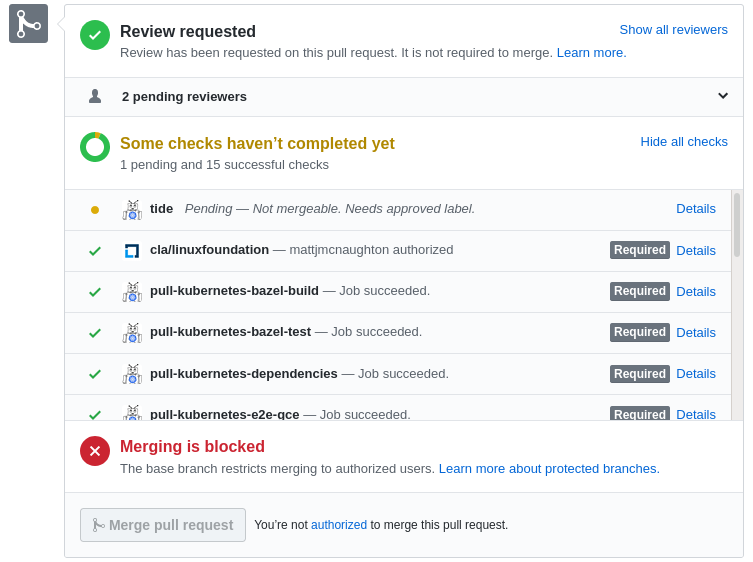Intro to Contributing to Kubernetes: Testing - Part 1

tl:dr;
By the end of this blog post, you’ll understand the tests your proposed Kubernetes diffs must pass before being merged. You’ll have all the background information to be ready for part 2 (coming soon), in which we discuss how to actually run all the different test suites locally.
Background
As a brief reminder, I’ve been focusing the majority of my open-source development capacity on Kubernetes for almost a year. During that time, and going forward, I’m writing blog posts geared towards potential new Kubernetes’ contributors. I hope these blog posts will augment existing Kubernetes documentation,1 and decrease the barriers for potential contributors to making meaningful commits.
For my next couple of blog posts, we’ll be examining how to test potential Kubernetes contributions. This post assumes you’ve read my k8s-dev-quick-start post, which covers forking and cloning the Kubernetes repo, ensuring the project builds, etc…
With all the development fundamentals in place, we can start thinking about testing!
Testing in k8s: A high level description
We’ll tackle testing in Kubernetes by focusing on the following three statements:
- Kubernetes supports unit, integration, and end-to-end (e2e) tests.
- All critical test suites must pass in CI before a diff is merged.
- Being comfortable running the test suites locally makes it easier to propose changes with confidence and leads to quicker iteration cycles (we touch on this point briefly in this post, but will predominantly address it in part 2).
Types of testing in Kubernetes
Each type of test has a slightly different purpose and as a result, slightly different guidelines. You can find the most up-to-date documentation via the sig-testing documentation but here’s a high-level summary.
Unit tests
When contributing to Kubernetes, you will most commonly interact with the unit tests. Almost every diff you submit should either add, or modify existing, unit tests. Unit tests should be very lightweight to work with, testing only a specific function in the code and executing very quickly. They should be fully hermetic (i.e. depend only on their declared inputs and depending on nothing on the local machine). See the Testing conventions documentation for further guidelines.
Integration tests
In Kubernetes, integration tests build on unit tests by allowing access to other
resources on the local machine. These “other resources” are most commonly etcd
or a service listening on localhost (like the Docker daemon).
All significant features require integration
tests, so you will add/update integration tests either when you add a
significant new feature, or you make significantly large change to an existing
feature that the integration test needs to be updated. See the Integration Test
documentation for more details.
e2e tests
E2E tests are the highest-level class of test in the Kubernetes ecosystem. They are designed to verify the end-to-end system behavior, and serve as a last signal to ensure the code is working as we intend. Given the complexity of Kubernetes as a distributed system with multiple components, this final check is vital to Kubernetes’ stability. E2E tests mirror a production k8s use-case as closely as possible. They have no bounds on the type of resources on which they can depend. They assume a fully functional Kubernetes cluster, and some even depend on a specific cloud provider. In fact, you’ll notice Kubernetes’ CI actually runs multiple different flavors of e2e tests, reflecting different combinations of external resources (i.e. different container runtimes, cloud providers, etc…).
Naturally, this lack of restrictions increases the complexity of the testing environment. Additionally, e2e tests are by far the most expensive with respect to runtime and most flake prone of the classes of tests. In short, they are a powerful tool for verifying correctness, but should be treated with caution. See k8s documentation on e2e tests and an enumeration of best practices when writing e2e tests in k8s for more information.
Role of testing in Kubernetes
When you create a PR, Kubernetes’ CI tooling will automatically run its test suite against it (add footnote describing /ok-to-test).
The following conditions must be met for before any pull request is merged to Kubernetes:
- All existing tests must continue to pass.
- Any new functionality must be tested via the appropriate mechanisms (i.e. unit, integration, or e2e tests depending on the nature of the change).
As we will explore in-depth in the next post, its easier to get your k8s PRs accepted if you create PRs which conform with the above stipulations from start.
Conclusion
And that’s it! In my next blog post, we will focus on how to actually run these different types of test locally, helping you increase your development velocity when working on Kubernetes.
1. When in doubt, https://github.com/kubernetes/community/tree/master/contributors/devel/sig-testing is our friend.